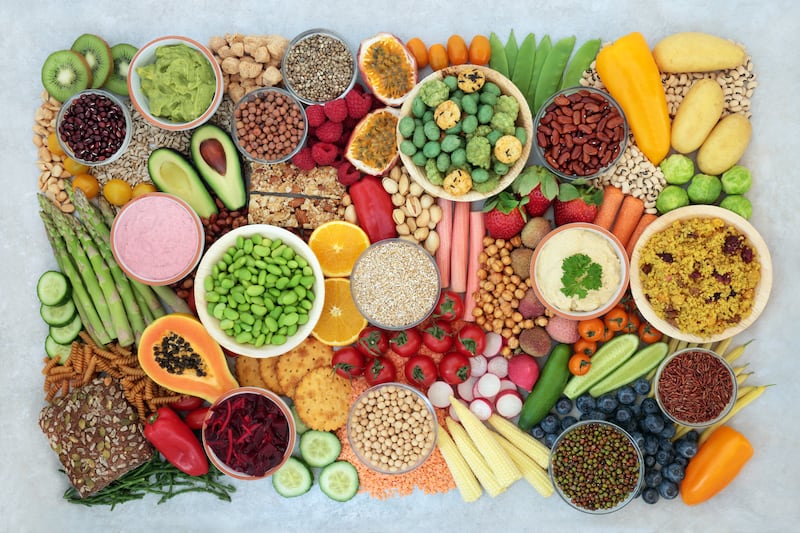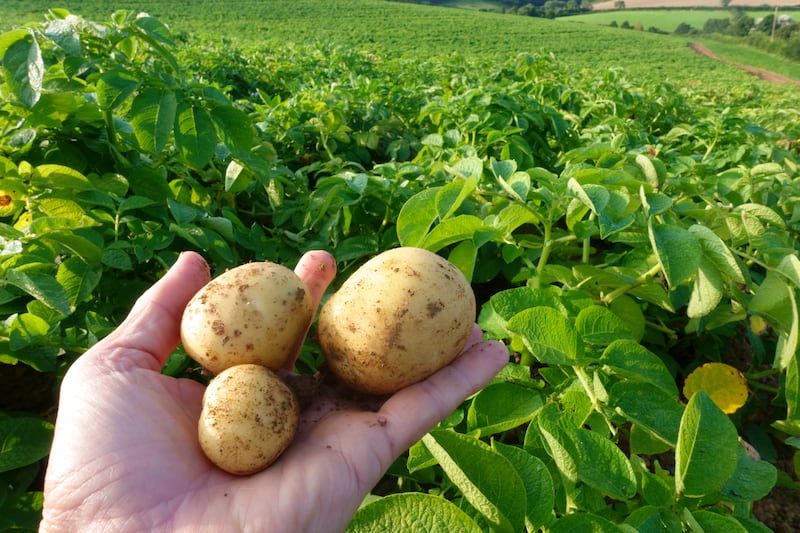What is the leading risk factor for diet-related ill health? Ultra-processed food? Too much salt, sugar or fat? According to a systematic analysis published in 2022, it is our low intake of wholegrains. Wholegrains contain B vitamins, folic acid, omega-3 fats, protein, antioxidants and micronutrients. And, crucially, they are packed with fibre.
“Fibre feels like the forgotten nutrient,” says Dr Samantha Gill, a specialist gastroenterology dietitian for the British Dietetic Association. “It has a reputation for being bland, boring and tasting like cardboard. On top of that, fibre is often related to bloating and flatulence.”
With an image like that, it is no wonder we don’t eat enough of it. Most countries have a recommended daily fibre intake of 30g for adults; the Irish target is between 24-35g. All countries are falling short. Just 3 per cent of people in Canada, 5 per cent of those in the US and 9 per cent of those in the UK meet the guidelines. Even in Germany, where people eat the most fibre in Europe, intake tops out at about 25g.
“There is a big fibre gap,” says Gill. “In the UK, we’re only eating about 19g fibre daily.”
RM Block
Fibre is a type of carbohydrate found in plants. As well as wholegrains, it is in vegetables, fruit, nuts, seeds, herbs, spices and legumes.
“Fibre isn’t easily broken down in the gut, unlike other carbohydrates,” says Gill. “Instead, it travels down your gut, passing through your small and large intestine.” Its best-known health effect is preventing constipation. “Some types of fibre bulk out stools and improve consistency, which makes them soft and easy to pass,” she says.

But there is far more to fibre than keeping you regular. A landmark study published in 2019 showed that a fibre-rich diet reduces the risk of heart disease, stroke, type 2 diabetes and colon cancer by 16-24 per cent. In 2015, the Scientific Advisory Committee on Nutrition in the UK found that every 7g daily increase in fibre (half a tin of baked beans) can lower your risk of noncommunicable diseases by up to 9 per cent. More recent studies have found that fibre also contributes to a healthy gut microbiome and brain.
“The reason fibre can affect so many areas of health is because it is not a single entity,” says Gill. “Fibre is an umbrella term and there are many different types that behave in different ways when they reach the gut.”
A study looking at whether 30g a day was achievable found barriers including “a lack of awareness regarding the health benefits of fibre beyond bowel health”, and “negative perceptions of starchy foods”, which are often perceived as fattening.
[ Protein: Are we eating enough of it? And is ‘high protein’ branding just a fad?Opens in new window ]
In Denmark, the Danish Whole Grain Partnership, a public-private enterprise to increase wholegrain consumption, has been a massive success. Between 2008 and 2019, the average daily intake of wholegrains rose by 128 per cent, and the share of the population eating the recommended amount of wholegrains daily increased from 6 per cent to 54 per cent.
In the absence of any similar programme here, how can you up your fibre intake? Experts advise doing it gradually to avoid side-effects such as discomfort, bloating and wind, and drinking lots of water (fibre draws water into the bowel, so you can become dehydrated if you don’t drink enough). Those with conditions such as irritable bowel syndrome may find their tolerance varies, but for everyone else, says Gill, “the more fibre the better”.
Thirty ways to get your 30g a day
1 Base all three meals on starchy foods – mainly wholegrains and skin-on potatoes.
2 Aim for eight portions of vegetables and fruit a day (five is not enough!).
3 Eat a couple of high-fibre snacks a day: unsalted nuts and seeds, slices of fruit dipped in nut butter (chunky has more fibre than smooth), slices of veg dipped in hummus, wholegrain crackers, toasted seaweed ...
4 Move more. Studies from Ireland found that those who meet the fibre recommendation eat more food overall, so you need to work up an appetite.
5 If you eat breakfast cereal, choose porridge/overnight oats, no-added-sugar muesli, Weetabix, Shredded Wheat, Bran Flakes or similar. Go half-and-half with your regular cereal if that makes it easier. Top with fruit, nuts and seeds.

6 Eat the whole fruit. This is far better than drinking juice, which has no fibre. Smoothies have a small amount – more if you make your own and add oats, nut butters and seeds. A maximum daily portion of smoothie or juice is 150ml, probably smaller than you think.
7 Look at the label. A food is “high in fibre” if it contains at least 6g per 100g, or a “source of fibre” if it contains at least 3g/100g. Fibre is usually listed on the back of the pack.

8 Don’t peel your potatoes. Baked potatoes, boiled new potatoes and sweet potato wedges are all good. If you fancy mash, scoop out the flesh of baked potatoes and eat the skins another time. Keep the skins on other fruit and vegetables whenever you can, too, including root veg, kiwis, cucumber, apples and aubergine.
9 Go for wholemeal, rye or granary bread. To wean yourself off white, try a 50/50 loaf. If all else fails, choose added-fibre white bread. Stuff sandwiches with salad.
10 White rice is low in fibre – switch to brown, or even better, black or red. Ditto pasta: ditch white for wholewheat. If you don’t like wholewheat, try a legume-based pasta made from red lentils or green peas.
11 Eat plenty of vegetables: in sauces, stews and curries; as side dishes; in salads. Eat the rainbow – particularly high-fibre vegetables include parsnips, broccoli, peas, green beans, sweetcorn, carrots, brussels sprouts and cauliflower.
12 In fact, go vegan! OK, that might be a bit extreme for most people, but vegan and vegetarian diets tend to be high in fibre. Perhaps consider some plant-based days each week.
13 With fruit, vegetables and pulses, fresh, frozen, dried and tinned (in natural juices/water) all count. Make life easier with a freezer full of frozen peas, spinach and berries, and a cupboard stocked with tinned sweetcorn and beans.
14 Try new fruits or vegetables regularly to cover all fibre bases. For example, chicory and jerusalem artichokes are a source of oligosaccharides, a kind of prebiotic. Don’t forget fungi – mushrooms are an often overlooked but rich source of fibre.
15 Vary your wholegrains: try bulgur wheat, barley, rye, buckwheat, quinoa and couscous.
16 Have fresh or dried fruit, or tinned fruit in natural juice, for dessert. Dried fruit is typically higher in fibre than fresh, but it can increase the risk of tooth decay, so it’s better eaten as part of a meal, rather than a snack. High-fibre fruits include figs, berries, pears, apples, bananas, melons, avocado, dried apricots, raisins and prunes.

17 Use lots of herbs (fresh and dried) and spices.
18 Simple swaps can make a big difference. For breakfast, swap two slices of white toast with jam and a glass of orange juice (1.6g total fibre) for two slices of wholemeal toast with peanut butter and an orange (8.3g). If you can’t give up the jam, mix in some chia seeds.
19 As a mid-morning snack, instead of plain yoghurt (no fibre), add some strawberries and almonds (5.5g).
20 At lunchtime, instead of white spaghetti with a tomato-based sauce (3.9g), have wholewheat spaghetti with a lentil and tomato-based sauce (10.9g).
21 During an afternoon slump, instead of cream crackers with cheddar cheese (0.9g), have rye crackers with hummus (8.5g).
22 For dinner, instead of chicken breast, mashed potato and carrots (4.7g), have chicken breast, baked potato, carrots and green beans (11.2g). In total, these swaps take your daily fibre intake from 11.2g to 44.4g. For more ideas, check out the British Nutrition Foundation’s seven-day 30g fibre meal plan.
23 Add pulses. If you’re making a mince-based dish such as spaghetti bolognese, lasagne, chilli con carne or shepherd’s pie, replace half the meat with pulses such as chickpeas or lentils. (For meatballs, use 50 per cent oats.) Add beans to soups and stews, and sprinkle seeds on top.
24 In a rush? Two slices of wholemeal toast with baked beans provides more than a third of your daily fibre intake.
25 Use nutritional yeast in place of Parmesan on pasta, in pesto or anywhere you want a cheesy hit.
26 Fancy a pizza? Add vegetable toppings and have it with a side salad.
27 Use tahini in home-made hummus, sauces and desserts – sesame seeds are particularly high in fibre.
28 If baking bread, cakes or biscuits, use wholewheat or oat flour, or mix 50:50 with white flour. Look for recipes that use fruit and veg: banana bread, beetroot or avocado brownies, carrot or parsnip cakes ...
29 High-fibre treats include flapjack, dark chocolate and popcorn. Even crisps contain a bit of fibre – look for root vegetable and skin-on varieties.
30 Don’t spend money on fibre supplements (unless advised to by a doctor). Potatoes, oats, lentils and beans are some of the cheapest, most filling foods around – and the best way to get your fibre fix. – Guardian


















